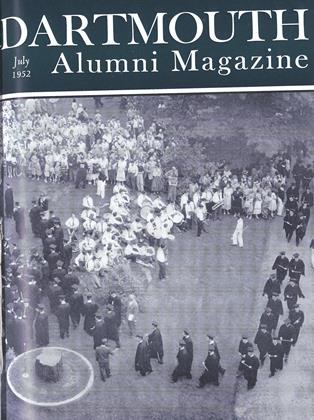by Prof. John L. Stewart. Prentice-Hall,1952. pp. xxx, 3-645.
It is most pleasant, in this swarming day of the hasty omnibus, assembled by scissors-happy savants and printed by pullulating publishers, to discover a carefully prepared and intelligently organized anthology. It is even more pleasurable to find a gathering of significant literary material, vital, extensive, and yet representative of its genre. Professor Stewart is doubly to be congratulated for his fine collection The Essay: A Critical Anthology.
Mr. Stewart divides his anthology into five parts: a general introduction, three thematic subdivisions of material, and a section of questions on the reading. In 17 pages of packed introduction, he defines the modern essay ("any short, unified work of nonfictional prose having some degree of complexity and dealing with a single subject"), shows how widespread the essay remains, and provides a detailed and illuminating method of analyzing it. In section one ("Facts and Explanations") Professor Stewart presents essays designed to tell what things are and how to use them. In section two ("Interpretations and Evaluations") he brings us essays exploring the social, ethical, and aesthetic values of things. Here, in the deepening plan of the book, one finds A. N. Whitehead's "Science in General Education" and Cleanth Brooks' "What does Poetry Communicate?" With section three ("Literary Art and Creative Imagination") Stewart moves on to the richer yet more complicated literary essay. And now we can observe the fine planning of his text. Having included a factual biography in section one and historical essays in two, he now includes biographical and historical essays essentially "literary" in vocabulary, imagery, complexity, and shaping—such essays as Strachey's "Dr. Arnold" or Allen Tate's "The Death of Stonewall Jackson."
At the end of this great wealth of abundance wisely-chosen comes a section of questions on the reading. Although one may guess that this springs from the publisher's scheming and although one may deplore on principle such an invasion of teaching rights, one must confess that Mr. Stewart's queries are pointed, searching, and provocative, leading the student a full awareness of the style clothing the content.
This is one textbook out of many—one whose wide range should delight the student, whose tough core of reading make him ornament himself in learning, whose high level of commentary should increase his ability to judge and dispose of his intellectual business.
 View Full Issue
View Full Issue
More From This Issue
-
 Article
ArticleThe Fifty-Year Address
July 1952 By E. BRADLEE WATSON '02 -
 Article
ArticleThe 1952 Commencement
July 1952 -
 Article
ArticleBaccalaureate Address
July 1952 By SIR OLIVER S. FRANKS -
 Article
ArticleDartmouth Awards Mine Honorary Degrees
July 1952 -
 Class Notes
Class NotesThe Big 25th for 1927
July 1952 By DOANE ARNOLD '27 -
 Class Notes
Class NotesA Glowing 190 7 Report
July 1952 By H. RICHARDSON LANE '07
Books
-
 Books
BooksFaculty Publications
January 1933 -
 Books
BooksSHAKSPERE, SHAKESPEARE AND
April 1938 By Anton A. Raven. -
 Books
BooksOLD GLAMORS OF OLD AUSTRIA
DECEMBER 1930 By Arnold K. Borden -
 Books
BooksTHE FEDERAL BULLDOZER – A CRITICAL ANALYSIS OF URBAN RENEWAL, 1949-1962.
FEBRUARY 1965 By FRANK SMALLWOOD '51 -
 Books
BooksNotes on an expatriate's look homeward and on a bookman in a vast, sparsely inhabited region
October 1976 By R.H.R. -
 Books
BooksAN OUTLINE OF ECONOMIC PRINCIPLES AND PROBLEMS
February 1940 By Richard L. Funkhouser '30


